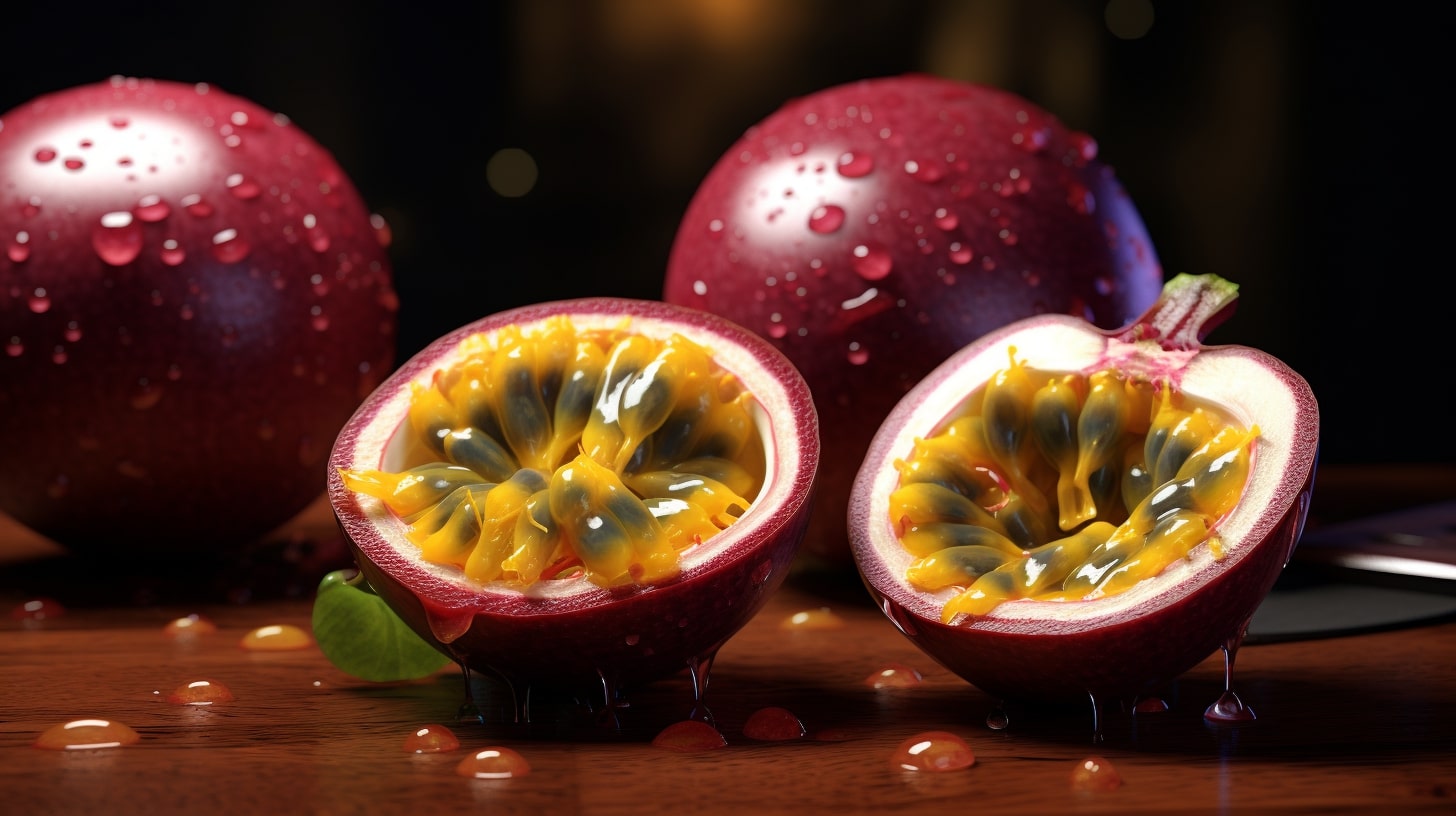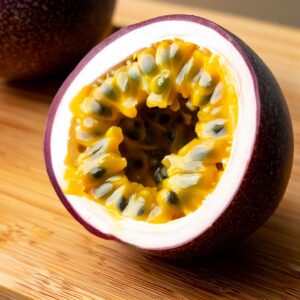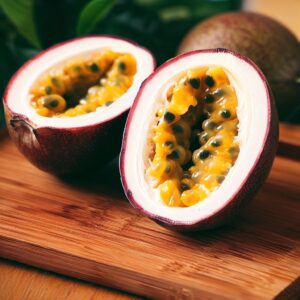Physical Address
304 North Cardinal St.
Dorchester Center, MA 02124
Physical Address
304 North Cardinal St.
Dorchester Center, MA 02124

Passion fruit is a delicious tropical fruit that can be enjoyed in a variety of ways. This tangy and sweet fruit is not only mouthwatering but also packed with nutritional benefits. Whether you want to eat it raw or incorporate it into recipes, passion fruit is sure to delight your taste buds and provide you with a tropical adventure.
To get the most out of your passion fruit, it’s important to know how to choose and prepare it. Look for passion fruits that are deep purple in color, slightly wrinkled, and feel full when shaken. Once you have your ripe passion fruit, wash it thoroughly and cut it in half using a serrated knife.
Now comes the exciting part – scooping out the juicy pulp. Use a spoon or fork to gently scoop out the orange flesh, being careful not to scrape the bitter white layer surrounding it. The edible seeds can be enjoyed alongside the flesh, adding a delightful crunch to each bite.
If you prefer to eat passion fruit raw, simply enjoy the juicy seeds and flesh as is. The combination of sweet and tart flavors is a treat for your taste buds. But if you want to take it up a notch, there are plenty of ways to incorporate passion fruit into various recipes.
Passion fruit is a versatile ingredient that can be used in making refreshing passion fruit juice, tropical margaritas, or even a delectable jam. You can also add it to yogurt for a burst of flavor or use it as a topping for ice cream. The possibilities are endless when it comes to experimenting with this tropical fruit.
Key Takeaways:

Before you can enjoy the unique taste of passion fruit, it’s important to choose a ripe fruit and prepare it correctly. To ensure you pick the perfect passion fruit, look for ones that are deep purple in color and slightly wrinkled. These signs indicate that the fruit is ripe and ready to be enjoyed.
You can also give the fruit a gentle shake to determine if there is a lot of liquid inside, which is a good indicator of juiciness. Once you’ve selected your ripe passion fruit, give it a thorough wash to remove any dirt or residue.
Now it’s time to open up the fruit and extract the delicious flesh. Using a serrated knife, carefully cut the passion fruit in half. The vibrant orange flesh and edible seeds are what you’re after. Take a spoon or fork and scoop out the pulp, being careful not to scrape the bitter white layer that surrounds it.
| Ripe Passion Fruit Characteristics | Preparation Steps |
|---|---|
| Deep purple color | Wash the fruit |
| Slightly wrinkled skin | Cut the passion fruit in half with a serrated knife |
| Full of liquid inside | Scoop out the orange flesh with a spoon or fork, avoiding the bitter white layer |
Once you’ve scooped out the passion fruit, you can simply eat it as is to enjoy its sweet and tart flavors. However, if you’re feeling adventurous, there are many ways to incorporate passion fruit into recipes. Try making passion fruit juice, margaritas, or jam. You can also add the pulp to yogurt for a tropical twist.
Remember, the seeds of the passion fruit are edible and can be enjoyed alongside the flesh. Any leftover passion fruit can be stored in the refrigerator wrapped in cling wrap or used as a natural fertilizer for your plants. With these simple steps, you’ll be savoring the delightful taste of passion fruit in no time.

If you prefer to enjoy passion fruit in its natural form, eating it raw is a simple and delicious option. This tropical fruit is known for its unique taste and can be a refreshing treat on its own or added to various dishes. When preparing passion fruit to eat raw, it’s important to choose a ripe fruit for the best flavor.
To select a ripe passion fruit, look for ones that are slightly wrinkled and deep purple in color. This indicates that the fruit is mature and ready to be enjoyed. You can also give the fruit a gentle shake to check if it feels full and has a lot of liquid inside. This ensures that the fruit is juicy and flavorful.
Once you have chosen a ripe passion fruit, it’s time to prepare it. Start by washing the fruit thoroughly to remove any dirt or debris. Then, carefully cut the passion fruit in half using a serrated knife. With the fruit cut in half, you can see the orange flesh and edible seeds inside.
Using a spoon or fork, scoop out the flesh of the passion fruit, being careful not to scrape the bitter white layer. The seeds are edible and can be enjoyed alongside the flesh, adding a slight crunch to each bite. Eat the passion fruit as is, or use it in various recipes like fruit salads, parfaits, or as a topping for yogurt or ice cream. Any uneaten passion fruit can be stored in the refrigerator wrapped in cling wrap or used as a natural fertilizer for plants.
| Benefits of Eating Passion Fruit Raw | Preparation Steps |
|---|---|
| – Tropical and refreshing taste | – Choose a ripe passion fruit |
| – Good source of vitamins and antioxidants | – Wash the fruit |
| – Edible seeds provide a slight crunch | – Cut the passion fruit in half |
| – Versatile ingredient for various recipes | – Scoop out the flesh |
| – Easy to store for future use | – Enjoy raw or use in recipes |
Passion fruit can be a versatile ingredient in a range of recipes, adding its distinct flavor to drinks, spreads, and desserts. Whether you’re looking to make a refreshing tropical drink or a deliciously sweet treat, passion fruit can elevate your culinary creations.
Check out this recipe for Passion Fruit Puree!
One popular way to enjoy passion fruit is through its juice. Simply scoop out the flesh and blend it with some water and a sweetener of your choice. You can also add a splash of passion fruit juice to margaritas for a tropical twist on a classic cocktail.
If you prefer something spreadable, try making passion fruit jam. Combine the pulp with sugar, lemon juice, and a pectin agent, and boil until thickened. This tangy and fruity jam pairs perfectly with toast, scones, or even as a filling for pastries.
| Passion Fruit Recipes | Description |
|---|---|
| Passion Fruit Juice | Blend passion fruit flesh with water and sweetener for a refreshing drink. |
| Passion Fruit Margaritas | Add a splash of passion fruit juice to classic margaritas for a tropical twist. |
| Passion Fruit Jam | Cook passion fruit pulp with sugar and lemon juice until thickened into a spreadable jam. |
| Passion Fruit Yogurt | Mix passion fruit pulp into yogurt for a tangy and tropical twist. |
If you’re a fan of yogurt, why not add some passion fruit to it? Simply mix the pulp into your favorite yogurt for a tangy and tropical twist. The combination of creamy yogurt and the tartness of passion fruit is a match made in heaven.
Passion fruit offers a unique flavor profile that can enhance a wide range of dishes. Whether you’re making drinks, spreads, or desserts, this tropical fruit is sure to add a burst of tropical goodness to your recipes.
Adding passion fruit to fruit salads and parfaits can transform them into vibrant and refreshing treats with a tropical twist. The tangy and aromatic flavor of passion fruit pairs perfectly with a variety of fruits, enhancing the overall taste and presentation of these dishes. Whether you’re looking to create a colorful summer fruit salad or a creamy parfait for a special occasion, incorporating passion fruit will take your creation to the next level.
To create a delicious fruit salad, start by selecting a mix of your favorite tropical fruits such as mangoes, pineapples, and kiwis. Cut them into bite-sized pieces and place them in a bowl. Next, slice open a ripe passion fruit and scoop out the pulp, including the edible seeds. Gently toss the passion fruit pulp with the other fruits, allowing the flavors to meld together. For a burst of freshness, you can also squeeze some lime juice over the salad.
If you prefer a more indulgent treat, try layering passion fruit pulp and Greek yogurt in a parfait glass. Start with a spoonful of passion fruit pulp at the bottom of the glass, followed by a layer of creamy yogurt. Repeat the process until the glass is filled, creating beautiful layers of vibrant colors. Top it off with a sprinkle of granola or chopped nuts for added texture and crunch.
| Fruit Salad Ingredients | Parfait Ingredients |
|---|---|
| Mangoes | Greek yogurt |
| Pineapples | Passion fruit pulp |
| Kiwis | Granola or chopped nuts |
| Passion fruit pulp | |
| Lime juice (optional) |
By adding passion fruit to your fruit salads and parfaits, you’ll not only elevate their taste but also bring a touch of the tropics to your table. So go ahead, get creative, and enjoy the delightful combination of flavors that passion fruit brings to these refreshing treats.

If you’re looking for a way to incorporate more tropical flavors into your diet, adding passion fruit to smoothies and juices can be a delightful choice. With its sweet and tart taste, passion fruit adds a burst of flavor that complements a variety of other fruits and ingredients. Whether you’re making a refreshing smoothie for breakfast or a vibrant juice for a midday pick-me-up, passion fruit can take your beverage to the next level.
One simple way to enjoy passion fruit in your smoothies is to blend it with other tropical fruits like pineapple, mango, and banana. The combination of these fruits with passion fruit creates a tropical flavor explosion that will transport your taste buds to a sunny beach. You can also add some yogurt or coconut water for a creamier texture.
When it comes to juices, passion fruit can be mixed with orange juice, apple juice, or even coconut water to create a refreshing and hydrating beverage. The tangy flavor of the passion fruit adds a delightful twist to classic juice combinations. Simply squeeze the juice from the passion fruit into your favorite juice and give it a good stir before enjoying.
| Benefits of Passion Fruit in Smoothies and Juices |
|---|
| 1. Burst of tropical flavor |
| 2. Rich in antioxidants |
| 3. High in vitamin C |
| 4. Adds a refreshing twist |
| 5. Enhances the nutritional value |
“Passion fruit brings a delightful tang to smoothies and juices, taking your taste buds on a tropical adventure!”
Incorporating passion fruit into your smoothies and juices not only adds a burst of tropical flavor but also provides a range of health benefits. Passion fruit is rich in antioxidants, which help protect your body from harmful free radicals. It is also high in vitamin C, which boosts your immune system and promotes healthy skin. By adding passion fruit to your beverages, you’re not only enhancing the taste but also increasing the nutritional value.
So why not give passion fruit a try in your next smoothie or juice creation? Its exotic taste and multitude of benefits make it a perfect addition to any tropical-inspired beverage. Get creative and enjoy the delightful flavors that passion fruit brings to your glass!
Passion fruit can be the perfect addition to your cocktail recipes, adding a tropical twist and a burst of flavor to your favorite mixed drinks. Whether you’re hosting a summer party or just looking to enjoy a refreshing beverage, incorporating passion fruit can take your cocktails to the next level.
The tangy and aromatic qualities of passion fruit make it an excellent choice for adding depth and complexity to your drinks. The juicy pulp and edible seeds provide a unique texture that adds visual appeal. Plus, the vibrant orange color adds a pop of brightness to any cocktail presentation.
From classic margaritas to exotic island-inspired concoctions, there are endless possibilities for incorporating passion fruit into your cocktail repertoire. The sweet and tart flavors of passion fruit complement a variety of spirits, including vodka, rum, tequila, and gin. You can experiment with different combinations, garnishes, and mixers to create your signature passion fruit cocktail.
| Passion Fruit Cocktail Ideas | Ingredients |
|---|---|
| Passion Fruit Mojito | Passion fruit, mint leaves, lime juice, simple syrup, white rum, soda water |
| Tropical Passion Martini | Passion fruit, vodka, pineapple juice, orange liqueur |
| Passion Fruit Margarita | Passion fruit, lime juice, tequila, triple sec, simple syrup, salt rim |
| Passion Fruit Caipirinha | Passion fruit, lime wedges, sugar, cachaça |
Don’t be afraid to get creative and experiment with different flavors and ingredients. Whether you prefer a sweet and fruity cocktail or a tangy and refreshing one, passion fruit can elevate your mixology skills and impress your friends with unique and delicious drinks.
If you have a sweet tooth, incorporating passion fruit into jams, jellies, and desserts can take your treats to a whole new level of tropical deliciousness. The unique flavor of passion fruit adds a tangy and aromatic twist to traditional jam and jelly recipes, making them more vibrant and exotic. Whether you enjoy it on toast or as a topping for pancakes, passion fruit jam is sure to impress your taste buds.
Passion fruit also lends itself well to creating mouthwatering desserts. Imagine biting into a luscious passion fruit tart with a buttery crust and a silky smooth filling. The combination of sweet and tart flavors will leave you craving for more. You can also experiment with using passion fruit in cakes, adding a tropical flair to your favorite recipes. The fruit’s natural acidity pairs wonderfully with creamy cheesecake filling, making it a delightful addition to any dessert spread.
If you’re feeling adventurous, try making passion fruit curd. This versatile and velvety spread can be used in a variety of ways, from filling tarts and pastries to layering cakes and cupcakes. The vibrant color and tangy taste of passion fruit curd will elevate your desserts to a whole new level. Its tropical flavor profile is perfect for those looking to add an exotic touch to their culinary creations.
| Jams, Jellies, and Desserts | Description |
|---|---|
| Passion Fruit Jam | A tangy and aromatic twist on traditional jam recipes, perfect for spreading on toast or using as a pancake topping. |
| Passion Fruit Tart | A buttery crust filled with a silky smooth passion fruit filling, creating a delightful balance of sweet and tart flavors. |
| Passion Fruit Cake | Adding passion fruit to cakes brings a tropical flair to your favorite recipes, making them even more irresistible. |
| Passion Fruit Cheesecake Filling | The natural acidity of passion fruit complements creamy cheesecake, creating a heavenly combination of flavors. |
| Passion Fruit Curd | A versatile and velvety spread that can be used in various desserts, adding a vibrant color and tangy taste. |
So, the next time you’re planning to indulge in a sweet treat, consider incorporating passion fruit into your jams, jellies, and desserts. Its tropical and tangy flavor will transport you to paradise with every bite. Get creative in the kitchen and let passion fruit take center stage in your culinary creations, adding a burst of exotic deliciousness to your favorite sweets.

Beyond its delightful taste, passion fruit offers a range of nutritional benefits that can support your overall health and well-being. Rich in antioxidants, passion fruit helps protect your cells from damage caused by harmful free radicals, which can contribute to chronic diseases and aging. Antioxidants also play a vital role in boosting your immune system and reducing inflammation in the body.
Passion fruit is a great source of vitamin C, which is essential for collagen production and immune function. It also contains dietary fiber, which aids in digestion and promotes gut health. Fiber can help regulate blood sugar levels, support weight management, and reduce the risk of heart disease.
This tropical fruit is also packed with potassium, an electrolyte that helps maintain healthy blood pressure levels and supports heart health. Additionally, passion fruit contains dietary nitrate, a compound that has been found to improve blood flow, lower blood pressure, and promote cardiovascular health.
Studies have shown that passion fruit may have anticancer properties due to its high levels of antioxidants and other bioactive compounds. These compounds have been found to inhibit the growth of cancer cells and reduce the risk of certain types of cancer.
| Nutrient | Amount per 100g |
|---|---|
| Calories | 97 |
| Protein | 2.2g |
| Fat | 0.7g |
| Carbohydrates | 22.4g |
| Fiber | 10.4g |
| Vitamin C | 30mg |
| Potassium | 348mg |
Passion fruit also contains several other essential vitamins and minerals, such as vitamin A, iron, and calcium. It may also have benefits for skin health, sleep aid, and stress relief due to its calming properties and the presence of certain compounds that promote relaxation.
With its delicious taste and impressive nutritional profile, incorporating passion fruit into your diet can be a flavorful and healthy choice. Whether enjoyed raw or used in a variety of recipes, this tropical fruit provides a burst of flavor and a range of health benefits that can enhance your well-being.
Passion fruit is a fruit that carries with it a sense of tropical adventure, originating from various regions around the world. Known for its vibrant purple or yellow round shape and smooth, waxy skin, passion fruit is a true delight for the senses.
The Caribbean is one of the regions where passion fruit thrives, with its warm climate and ideal growing conditions. Brazil, Paraguay, Australia, and New Zealand are also known for their passion fruit production, adding to the global availability of this exotic fruit.
Whether you’re exploring the tropical beaches of the Caribbean or enjoying a taste of paradise from your own kitchen, passion fruit brings a burst of flavor and a touch of adventure to any culinary experience. So why not embark on your own tropical journey and savor the unique taste and aroma of passion fruit today?
| Passion Fruit | Origins |
|---|---|
| Caribbean | Warm climate and ideal growing conditions |
| Brazil | Tropical climate |
| Paraguay | Rich soil and warm temperatures |
| Australia | Varied climates suitable for passion fruit cultivation |
| New Zealand | Temperate climate conducive to passion fruit growth |
Passion fruit is a versatile tropical fruit that can be enjoyed in numerous ways, offering a unique taste and a wealth of health benefits. Whether you choose to eat it raw or incorporate it into your favorite recipes, passion fruit is sure to delight your taste buds and provide a refreshing tropical experience.
To prepare passion fruit for consumption, look for fruits that have a deep purple color and are slightly wrinkled. You can also shake the fruit to ensure it feels full and has plenty of liquid inside. Once you’ve washed the passion fruit, cut it in half using a serrated knife and carefully scoop out the orange flesh, being mindful not to scrape the bitter white layer.
Passion fruit can be enjoyed as is, with its edible seeds adding a delightful crunch alongside the sweet and tart flesh. Alternatively, you can explore the culinary possibilities of passion fruit by incorporating it into various recipes. From making passion fruit juice and margaritas to creating jams and adding it to yogurt, there are endless ways to enjoy this tropical fruit.
In addition to its delicious taste, passion fruit also offers numerous health benefits. It is rich in antioxidants, vitamin C, fiber, and potassium. It may help with heart health, blood pressure regulation, immune system support, and even provide potential anticancer properties. Passion fruit has also been known to contribute to better skin health, aid in sleep, and relieve stress.
So, whether you’re looking for a refreshing snack, a vibrant addition to your favorite dishes, or a boost of nutrition, passion fruit is a fantastic choice. With its tropical allure and versatile nature, this fruit is sure to add a touch of exotic flavor to any culinary adventure.
A: Look for passion fruits that are slightly wrinkled and deep purple in color. You can also shake the fruit to see if it feels full and has a lot of liquid inside.
A: Wash the passion fruit, then cut it in half using a serrated knife. Scoop out the orange flesh with a spoon or fork, being careful not to scrape the bitter white layer.
A: Yes, you can eat passion fruit as is. The seeds are edible and can be enjoyed alongside the flesh.
A: Passion fruit can be used in various recipes, such as making passion fruit juice, margaritas, jam, or adding it to yogurt. It’s a versatile fruit for culinary creations.
A: Absolutely! Adding passion fruit to fruit salads and parfaits can enhance their tropical flavors and give them a unique twist.
A: Yes, passion fruit can be a refreshing addition to smoothies and juices, bringing a burst of tropical goodness to your beverage.
A: Absolutely! Passion fruit can be a delightful addition to cocktails, bringing aromatic and floral notes to the mix.
A: Yes, passion fruit can add a delightful taste and texture to jams, jellies, cakes, tarts, cheesecake fillings, and even passion fruit curd.
A: Passion fruit is rich in antioxidants, vitamin C, fiber, potassium, and dietary nitrate. It may have potential health benefits for heart health, blood pressure, immunity, skin, and stress relief.
A: Passion fruit is associated with the Caribbean, Brazil, Paraguay, Australia, and New Zealand, and it has a tropical allure and exotic appeal.

I’m Rachel Cooper, the brain and heart behind AboutWeirdFruits. If you’re here, you probably share the same insatiable curiosity for the fascinating world of exotic fruits that I do. From the spiky Durian to the unique Buddha’s Hand, I’ve been captivated by the diversity, flavors, and benefits these rare fruits bring into our lives.